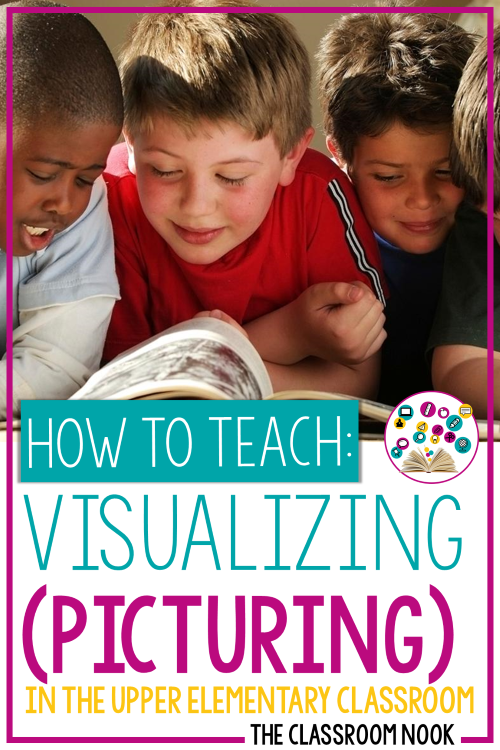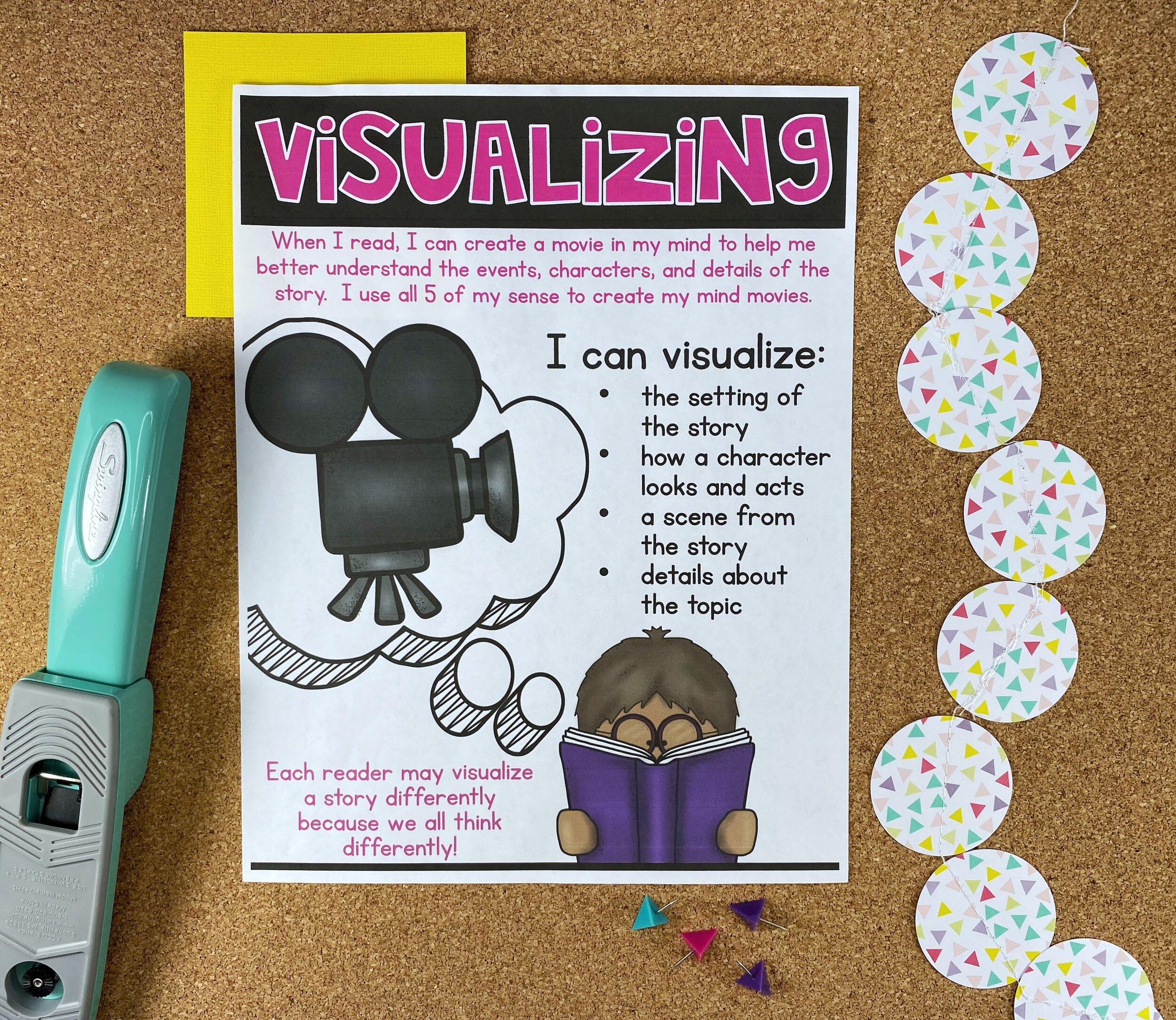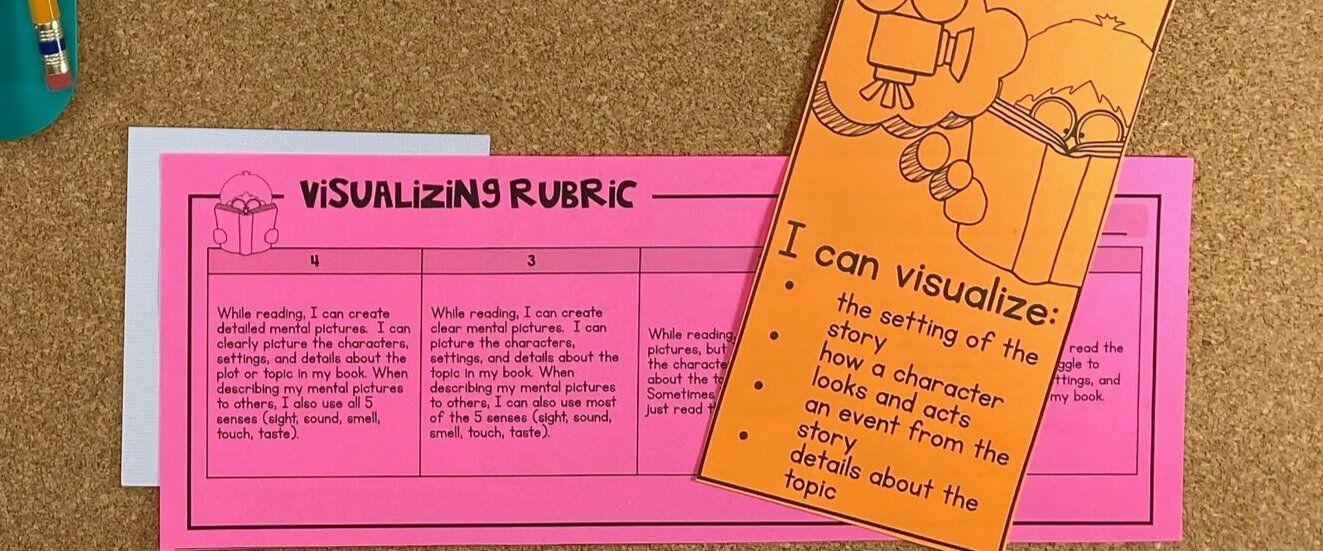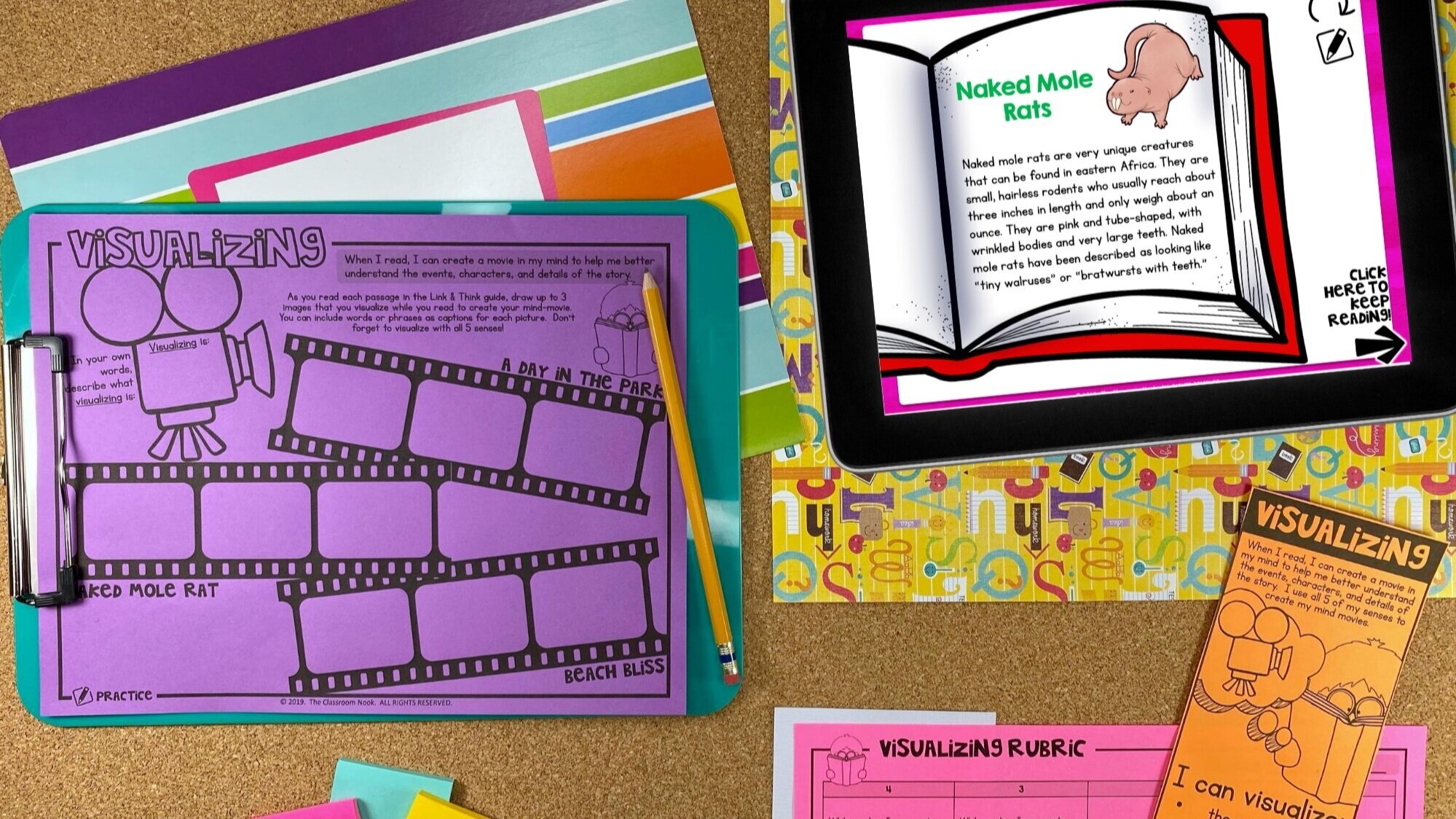Reading With Comprehending and Visualization of an Account
Reading Comprehension Strategy Serial: How To Teach Visualizing in the Upper Elementary Classroom

As adults, information technology's hard to imagine NOT visualizing while we read, since it comes then naturally to a seasoned reader. But, for kids, they may not have been taught to focus their mind in that way. That'southward where clear reading comprehension strategy instruction on visualizing, or picturing as some teacher refer to it as, comes into the…well, picture (pun intended)!
When nosotros teach reading comprehension strategies specifically, including visualizing, we give our students a framework and a blueprint for how to Think nearly what they are reading.
This framework leads to a deeper understanding of a text and helps students to interact with what they are reading. When students using reading strategies like visualizing (as we will talk over in great lengths in this postal service), they go active participants in their learning.
Pssst…Desire a super engaging and interactive style to take students exercise visualizing?
LINKtivity® Interactive Guides are EXACTLY what you need to make learning fun & accessible for all!
Get access to the Visualizing LINKtivity® (+60 others and counting!) inside of LINKtivity® Learning - an all-access pass to our entire vault of LINKtivities!
Beneath are the different categories inside this post to assist you bound to exactly what y'all need! Click on each category title to navigate there straight:
<< Back to categories
what you lot need to know before didactics The Visualizing Reading Strategy:
One of the nearly mutual ways to teach students visualizing is to depict information technology as creating a picture or movie in our mind. We want students to constantly exist adding to, changing, tweaking, and revising their mental images merely similar a movie is constantly evolving. In fictional texts, readers should visualize the settings, characters, and fifty-fifty the deportment of those characters. In doing so, readers will have a ameliorate understanding of the story as a whole. In nonfiction texts, we want our readers to visualize the details about the topic, or the event in history in society to fully grasp the concept. Visualizing isn't something that readers should exist doing periodically, it'south something that should be ongoing for the unabridged length of the story.
Although the strategy is chosen "visualizing," we should also encourage students to use all 5 of their senses, when appropriate, to really get the all-time mental paradigm. For example, we don't want students to just motion-picture show what a character looks similar, but also what they sound like. If that grapheme is eating their favorite food, we desire students to imagine what that nutrient smells and tastes like, too.
I of the best things nigh the visualizing strategy is that there is actually no right or wrong answer. When readers visualize as they read, they rely on information from the text as well every bit their own prior knowledge to create mental images of what is happening in the story. Each reader may create unique images, equally prior knowledge volition differ between each reader.
<< Back to categories
Introducing the Visualizing strategy to students

The concept of visualizing is typically easy for students to understand. Introducing visualizing can exist washed through a uncomplicated drawing activity. Give students a specific thing to draw, only exercise not offer whatever specific details about what it should wait like. For case, you may ask students to depict a clown, a beach scene, or a house. Allow students to depict the object or scene as they imagine it in their mind. And then, allow students to share their drawings with a partner. This volition help illustrate the idea that we all visualize something unlike considering our experiences are different. Someone who has been to a circus might have a dissimilar image than a educatee who has but seen clowns on Television or in books. Our experiences inform our mental images.
<< Dorsum to categories
Modeling how to Visualize
Educational activity reading strategies unremarkably starts with modeling through a read-aloud. Choose a text to share and be sure to pre-read that book and set up for places that you will end to model the mental images that yous are creating. You may want to take a whiteboard or chart paper bachelor to really draw, or have the drawings prepared ahead of time, to show your students when explaining your mental images. You can too depict your mental images on postal service-it notes and place them on the actual page in the story that sparked the mental epitome. Once more, these images can be drawn in real time with students or prepared alee of fourth dimension to share with the students equally you get to that office in the story. Exist sure to showcase all 5 senses when describing your mental picture.
As students go familiarized with this strategy, invite them to create their own images using all v senses during a read-aloud. Accept students share their drawings with a partner. Go along to remind students how our mental images vary because each of our experiences vary.
<< Back to categories
CHOOSE TEXTS THAT Help IN VISUALIZING:
Of course we want students to exist able to visualize regardless or what book they are reading. However, as students accept their first experiences working this this strategy, choose books that lend themselves to visualizing volition assist students to have a quick win, and easily see this strategy in action.
Be sure to choose a volume that is full of descriptive linguistic communication and details. Books with more obvious examples will help ready students up for success and will train their brains to actually paint vivid images in their minds.
Here are some of my favorites: (affiliate links)
-
A Bad Instance of Stripes by: David Shannon
-
Color Me a Rhyme past: Jane Yolen
-
Cloudy With a Take a chance of Meatballs past: Judi Barrett
-
The Salamander Room by: Anne Mazer
<< Back to categories
PRACTICING Visualizing:
CREATE Simple VISUALS TO REMIND STUDENTS TO VISUALIZE:

Students will demand ample time to practice this strategy with you in guided reading or strategy groups too as with their independent books. In all settings, students volition need simple visuals to help them think to use this strategy often. For case, a bookmark highlighting the strategy will aid remind students to visualize while independent reading, or while reading in small groups.
Also, a colorful classroom poster to refer to is as well a friendly reminder to keep creating mental images while reading. Create a bulletin board set where y'all begin to highlight each reading strategy every bit you lot introduce them to your students. Students can refer to the message board all twelvemonth long!
Create on-going ballast charts of the mental images that you are creating during read-aloud modeling. These mental images, forth with any written descriptions that you include with them will serve every bit bang-up examples for students when creating their ain mental images.

8 FREE Reading Strategy Bookmarks
Catch these Complimentary student bookmarks to help your students use reading comprehension strategies while reading.
There are a full of 8 bookmarks that explain reading strategy in kid-friendly language and is the perfect reference for students to use during independent or pocket-size-grouping reading time.
Utilise LINKtivity DIGITAL LEARNING GUIDES
New to LINKtivities? >> CLICK HERE
Teachers - if I've said it once, I've said it a million times - LINKtivity® digital learning guides are WHERE.IT'S.AT!
They are especially handy for providing students with concrete examples in a variety of means! And - they are PERFECT for teaching reading strategies similar visualizing. Bank check out the video below to see a sneak-peek!
Here'south how it works:
In the visualizing LINKtivity, students first watch a short animated video clip that chop-chop catches their attention with fun doodles and images. The clip introduces what the strategy is and how readers apply it.
From there they read alongside their "virtual reading buddy" to run across the strategy practical to a text. While clicking through the digital book, each time the educatee comes across a idea chimera, they click on it and are brought to a new slide in the LINKtivity guide to run into what their reading buddy is thinking!
Then, to take their learning to the next level, students read 3 boosted high-interest reading passages to practise the strategy on their own. In a similar fashion every bit they did with their reading buddy, students click through the digital storybook and finish to visualizing along the style.
Take STUDENTS Tape & SHARE THEIR MENTAL IMAGES:

Having students draw their mental images not simply helps continue them accountable while reading, but it besides helps them to to become better at applying the strateg. When drawing, encourage students to add together details using all 5 of their senses. When explaining their images to someone else, students can rely on these 5 senses to help describe their thinking.
Encourage students to include written descriptions of their mental images. This will assist them articulate their thinking and will help you to assess their application of the strategy.
<< Dorsum to categories
Assessing Your Students on Visualizing

Assessment informs education. Keep notes of when you find students using the strategy in whole-grouping, small-grouping, and individual settings. Here are some things to make note of when assessing a students' power to visualize:
-
How detailed are their descriptions are?
-
Do they utilize all 5 senses?
-
Practise the details they describe accurately portray what the text says?
-
Practice they visualize the near of import parts of the story, or are their mental images non relevant?
-
Do they need you lot to prompt them to use the strategy, or are they using information technology without assistance?
When it comes time to see how a student is performing with this reading strategy, use a rubric to help give you an understanding of how they are doing. Providing this same rubric to students in child-friendly language volition also help students know how they are doing every bit well and areas where they demand to improve.
<< Back to categories
Resource for Visualizing

Desire to get your easily on the Visualizing LINKtivity®?
Join the LINKtivity® Learning Membership and start using this set up-to-go resource for visualizing that includes:
-
a instructor guide
-
a educatee LINKtivity
-
a educatee recording canvass
-
a student-friendly rubric
Get admission to the Visualizing LINKtivity® PLUS all the other reading comprehension strategies inside of LINKtivity® Learning - an ALL-Admission pass to every single LINKtivity® created (INCLUDING all seven reading strategy LINKtivities!)
Cheque out the other posts in this series
williamsmucatinter.blogspot.com
Source: https://www.classroomnook.com/blog/teaching-visualizing
Post a Comment for "Reading With Comprehending and Visualization of an Account"